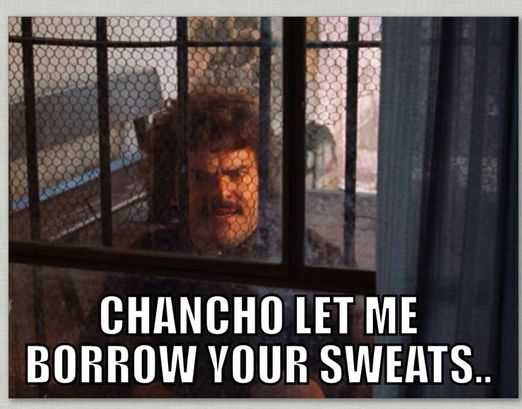 Comfort may not be a recipe for advancement as an organization but it holds keys to engaging customer service. The magical combination of folding laundry and thinking about sweat pants produced a certain epiphany – trendy changes but comfort does not. Why have sweat pants been around so long, even as distasteful as they are? Because they are comfortable. Trendy competitors to the sweat pant have included: Hammer pants, leotards, running pants, capris, yoga pants, etc. Many have also tried in various ways to make them more trendy, but the basic sweat pant will likely always be around. This evolutionary concept of comfort is observable in business as well and serves as an enlightening perspective when dealing with customers. As a general audience there are factors that will make most customers comfortable, these should serve as the core truths that we seek to understand with clarity so that we can implement with consistency. Comfort, or resistance reduction, should serve as a core component of our customer service efforts. It is important to be aware of the current (and ever evolving) trends that may affect customer expectations, but items such as ease of use will always be a high value. Some things do not change and mastering those are key. Clarify each of your customers expectations and take note of what will create a foundation of comfort as well as those unique details that will take your customer service experience into the five star realm – it may be as simple as printing “juicy” on an old pair of sweat pants. Originally posted at dyojo.wordpress.com
0 Comments
 Can't we all just get along? Can't we all just get along? Originally published as Shared Spaces: Shaking Up The Restoration In-Office Experience February 24, 2016 by Restoration & Remediation Magazine (R&R) By Jon Isaacson Could restoration companies benefit from a non-traditional work space? I started my career in property restoration in a shared office with myself, my manager and space designated for our crew to meet and interact. At most places I have worked since, the more normative office is laid out in designated segments of isolation. While I don't dismiss the value of personal space and enjoy my privacy as much as anyone, I have found the value of shared spaced and have worked to create open work space in every team that I have supervised. Shared Space Equals Shared Experiences When you share an office, you can feel the pulse of the team. You hear your team, even when you are not conversing with them directly, you are hearing their interactions. While there are times when the noise level has to be managed, when you hire people who are respectful they will likely already understand the dynamics of time and place in an open space. For our teams the benefits of a communal office within our department has far outweighed the perceived negatives. Imposing an open office on people who are not ready for it is a recipe for disaster. Transitioning to a shared space is made much more seamless when you have people who enjoy working together and/or you hire people who understand the culture. Implementing an open office is not of any benefit if it does not reflect your culture or add value to your team. Open Space Equals Open Communication Creating a shared space has allowed us to more readily share information at all levels of our department. Having our crew come into our office in the morning creates a natural opportunity to discuss the day's assignments. When the crew returns in the evening, we can debrief and discuss needs for the following day. These organic connection points throughout the day have increased our interactions at professional and personal levels. Combining our open space with making our workloads visible has helped us to elevate our clarity across our team interactions. Your office is your second home. Arguably, you spend more time in your work space with your work peeps than with your actual family, so making it an enjoyable and functional environment should be a priority. When drafting the plan for your work space - whether open, traditional or some other system with a fancy name - think about the following:
For our department, we have hired people who bring value to the team, we have been protective of the culture that we have developed and we have enjoyed the benefits of a shared work space. In the world of business we constantly hear about return on investment as we like to discuss whether the strategies we are employing are effective at reaching the goals we have set out. What if there were a minimal cost measure that consistently yielded high returns, would you incorporate that item into your organizational systems? Before we dive into the subject matter, take two minutes out of your day to view this video from KollektivetTV2 which may help set the state for how your team members and possibly even yourself feel about how you are valued in your organization: If you didn't find the video, apologies for wasting your time. Yet, can you empathize with the sentiment even as silly as it may be? How often do we as individuals, as team members, as managers, as leaders and even at home fail to provide sincere compliments for those around us? When was the last time that you received a sincere compliment?
Compliments are low cost and high yield investments in your most valuable assets as a leader, a coach, a parent and/or as a peer. A compliment requires no monetary exchange and yet it can brighten an individuals day, it can motivate them to carry out their work with pride and it can produce positively charged remunerative results throughout an organization. For years we have set aside time at the end of practice for our youth sports teams to have coaches and players compliment something positive that they saw a teammate doing, only recently did we attempt to incorporate this same practice within our work teams. For some reason as adults this can be awkward, but as individuals begin to think their week through to find something to compliment another team member it brightens the room. Compliments need to be sincere, they need to be specific and to get good at them it may take a little time as many of us are out of practice. Organizations are always discussing effective methods for rewarding employees and these are positive conversations that should be considered in depth, but before the process gets too complicated, don't forget to invest in the simple things - from the top down and from the bottom up, lead by example and let loose with some sincere compliments. Read more on this topic HERE. Tell us what you have tried and experienced with regards to this topic HERE.  If you have a team, especially a smaller team, there are no secrets – there are only those issues that you take leadership over and discuss with a purpose and those issues that you allow to direct their own lives. In most offices the walls are paper thin (if you still have walls) and the issues are being discussed like ping pong balls bouncing from surface to surface. As a leader you can be observe from your perch and imagine that you are the referee keeping the game within its imaginary bounds or you can grab a paddle and lead the discussion. There is safety on the sidelines, but it is only imagined, as those ping pong balls can cause real damages to teams and culture if they are not addressed. Leaders on the sidelines are not leaders, they are observers. Leaders who engage with their paddles will win some and will lose some, but by being present they can reduce negative impacts and even intercede in additional balls being added to the natural chaos of business life. There is no perfect leadership but there is definitely detrimental action/inaction by leaders. The ping pong balls are flying, its time to paddle up. |
AuthorThoughts on personal and professional development. Jon Isaacson, The Intentional Restorer, is a contractor, author, and host of The DYOJO Podcast. The goal of The DYOJO is to help growth-minded restoration professionals shorten their DANG learning curve for personal and professional development. You can watch The DYOJO Podcast on YouTube on Thursdays or listen on your favorite podcast platform.
Archives
March 2023
Categories
All
<script type="text/javascript" src="//downloads.mailchimp.com/js/signup-forms/popup/unique-methods/embed.js" data-dojo-config="usePlainJson: true, isDebug: false"></script><script type="text/javascript">window.dojoRequire(["mojo/signup-forms/Loader"], function(L) { L.start({"baseUrl":"mc.us5.list-manage.com","uuid":"b9016446bd3c6a9f0bd835d4e","lid":"83282ffb9e","uniqueMethods":true}) })</script>
|
Jon Isaacson |
Connect. Collaborate. Conquer.
© COPYRIGHT 2015. ALL RIGHTS RESERVED.
|



 RSS Feed
RSS Feed